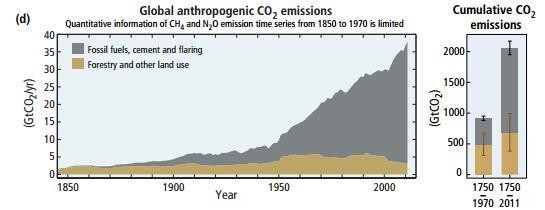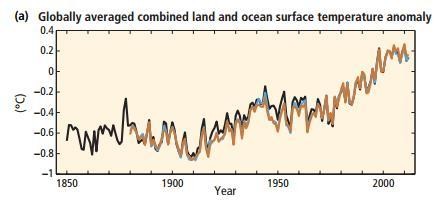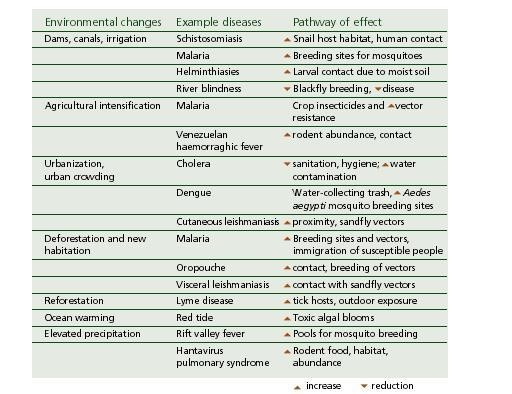What is climate change doing to our health?

Many people view climate change as a geographic and physical phenomenon, but there is a very real risk to our health too.
Image: REUTERS/Zoran Milich
Stay up to date:
Future of Global Health and Healthcare
We come together in Davos this year to discuss the Fourth Industrial Revolution, the previous ones outstripping our planet’s ability to sustain itself, consuming and dumping millions of tonnes of fossil fuels into our fragile ecosystem.
Man-made greenhouse gas emissions have increased since the pre-industrial era, driven largely by our economic and population growth. This has led to the highest atmospheric concentrations of carbon dioxide, methane and nitrous oxide in at least the last 800,000 years.

Source: IPCC
Several reports published by the Intergovernmental Panel for Climate Change (IPCC) have, year after year, demonstrated successive record breaking events across a range of geological parameters.
In the last century, the world has warmed by approximately 0.75 degrees Celsius, with each of the last three decades being successively warmer than any preceding decade since 1850. Since the beginning of the industrial era, oceanic uptake of carbon dioxide has resulted in its acidification; with a 0.1 pH decrease of ocean surface water corresponding to a 26% increase in acidity. Ocean warming has dominated the increase in energy stored in the climate system, accounting for more than 90% of the energy accumulated between 1971-2010. The annual mean sea-ice extent has been reducing at a rate of 3.5-4.1% per decade in the Arctic and 1.2–1.8% per decade in the Antarctic. Arctic sea-ice extent has decreased in every season and in every successive decade since 1979. Over the period 1901 to 2010, the global mean sea level has risen by an average of 19 centimeters.

Source: IPCC
What if we don’t act now?
If current levels of greenhouse gas emissions are to continue, this will cause further warming and long-lasting changes in all components of the climate system, increasing the likelihood of severe, pervasive and irreversible impacts for people and ecosystems, with uneven distributions, generally greater for disadvantaged people and communities.
Many people view climate change as a geographic and physical phenomenon, but there is a very real human and biological side too, with a host of related public health issues. If left unchecked, global warming will cause hundreds of millions of deaths across the world in the coming decades.
According to the World Health Organisation, taking into account only a subset of the possible health impacts, and assuming continued economic growth and progress in public health, climate change is expected to cause approximately 250,000 additional deaths per year between 2030 to 2050; 38,000 due to heat exposure in the elderly; 48,000 due to diarrhea; 60,000 due to malaria; and 95,000 due to malnutrition in children
This does not include the immeasurable deaths that will occur due to extreme climate events and forced migration. Broadly speaking, the effects on our health can be divided into four main categories.
1. Heat stroke and cardiovascular disease
Extreme weather events will affect rates of cardiovascular diseases (CVD) in several ways. Directly, the stress of an extreme event or anxiety over its recurrence is associated with increased myocardial infarctions (or heart attack) and sudden cardiac death. Indirectly, the displacement caused by a disaster is frequently associated with interruptions of medical services putting populations with chronic conditions at risk.
Cities and urban sprawl are more exposed to this risk due to the ‘Urban Heat Island’ (UHI) effect. High concentrations of buildings cause the generation and absorption of heat, making the urban centre as much as 3-5 degrees Celsius warmer than surrounding areas. This places added strain on the temperature regulating components of the body, principal of which are vasculature tone and body fluid content, influencing blood pressure control, cardiac output through fluid redistribution and kidney function.
Prolonged exposure can cause heat cramps and exhaustion leading to heat stroke and death; exacerbating pre-existing chronic conditions such as various cerebral and cardiovascular diseases, particularly in the elderly and frail. In the absence of any adaptation of the population, modeling done by the London School of Hygiene & Tropical Medicine has reported that heat-related deaths would be expected to rise by around 257% by the 2050s from its current annual baseline in the UK as a surrogate for the developed world.
An international study conducted in China, meanwhile, looked at population risk to CVD with changing temperature rather than just its rise. The study found those to be at the greatest risk were individuals who were subjected to fluctuating temperatures (both a rise and fall in ambient temperature), with cold effects lasting longer than hot effects.
2. Air pollutants and respiratory disorders
With a rise in air allergens, decrease in air quality and rising ozone levels, respiratory conditions - which already affect 334 million people with asthma globally and 210 million people with Chronic Obstructive Pulmonary Disease (COPD) – will be exacerbated.
Climate change has the potential to impact airway diseases by increasing ground level ozone and fine particle concentrations in the air. Air pollution is able to overcome the mucosal barrier in the lungs by inducing airway inflammation, resulting in allergen-induced respiratory responses. In addition, air pollutants fewer than 2.5 micrometers in diameter (PM2.5) and ozone may alter the allergenicity of aeroallergens like pollen, thereby promoting further airway sensitization.

These microscopic droplets lodge deep into lung tissue, causing serious health problems. Inhaling them triggers a variety of reactions including chest pain, coughing, throat irritation, and congestion; and worsens allergies, bronchitis and emphysema, by reducing lung function and inflaming the linings of the lungs - repeated exposure of which can permanently scar lung tissue. A study by the European Respiratory Society estimated that there would be 1,500 more annual ozone associated deaths by the year 2020 in the UK alone.
3. Vectorborne and zoonotic diseases (VBZD)
VBZDs are infectious diseases, the transmission of which involves either animal hosts or vectors serving as zoonotic reservoirs for human pathogens or as means in which they move between species. We are seeing an increasing emergence in zoonotic disease outbreaks with the majority of recent major human infectious disease outbreaks worldwide such as SARS, MERS and HIV/AIDS, originating in animals.
The link between malaria and extreme climatic events has long been studied. In India, excessive monsoon rainfall and high humidity has been identified to enhance mosquito breeding and survival. Recent analyses have also shown that the malaria epidemic risk increases five-fold in the year immediately after an El Niño event.
The use of a meteorological model and biological data regarding the brown dog tick, Rhipicephalus sanguineus, clearly indicates the climatic zone favorable for this tick species reproduction has expanded by 669% since the 1960s in Europe alone. By observing the activity of such tick vectors, over relatively short periods of time, provides evidence towards this growing problem. The same being true of other vectors like sandflies, mosquitoes, fleas, larvae, worms, insects, snails or other cold-blooded animals.

4. Malnutrition through food and water
According to the United Nations Development Programme, some 3.7 billion people worldwide are currently malnourished. Extreme weather events and changes in temperature and precipitation patterns will directly damage or destroy crops and other food supplies, as well as interrupt transportation chains.
Indirectly, there is potential for harm from malnutrition resulting from damage to agricultural crops and related trade, economic, and social instability; diversion of staple crops for use in biofuels, impaired ability to grow crops due to changing environmental conditions and water availability; and the reduced availability and nutritional quality of protein from fisheries, aquaculture, and other marine-based foods.
Food and water can also be a source of exposure to illnesses, resulting from the ingestion of microbes, chemical residues (such as pesticides, biotoxins) or other toxic substances. With a rise in the number of natural disasters and changing weather patterns, there will be a reduction in the supply of fresh drinking water. The WHO already estimates there are approximately 760,000 child deaths annually due to diarrheal diseases, and this huge number will only be compounded by the rise in floods, droughts and famines that climate change will bring.
The people of the world cheered their own fate and that of future generations this December in Paris, as 157 world leaders along with 40,000 delegates from 196 countries, came together to craft a legally binding climate accord, which could once and for all address the impact of climate change on our planet.
If we can work together to achieve these goals, then surely our human spirit of cooperation and excellence will allow us to create a remedial response to the damage of the last few centuries. To turn the clock back on our current unsustainable way of life and create a world which we are not dependent on oil and natural gas and one where we live within our means to create a lasting legacy for mankind which we can be proud of. This would be a truly fitting outcome for the Fourth Industrial Revolution.
Author: Marcus Ranney is Vice-President of RoundGlass Partners, India, and a Global Shaper. He is participating in the World Economic Forum’s Annual Meeting in Davos.
Don't miss any update on this topic
Create a free account and access your personalized content collection with our latest publications and analyses.
License and Republishing
World Economic Forum articles may be republished in accordance with the Creative Commons Attribution-NonCommercial-NoDerivatives 4.0 International Public License, and in accordance with our Terms of Use.
The views expressed in this article are those of the author alone and not the World Economic Forum.
Related topics:
Forum Stories newsletter
Bringing you weekly curated insights and analysis on the global issues that matter.
More on Forum InstitutionalSee all
Victoria Masterson, Stephen Hall and Madeleine North
March 25, 2025
Lorez Qehaja
March 19, 2025
Madeleine North
January 28, 2025





